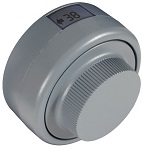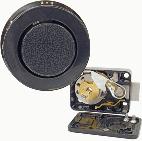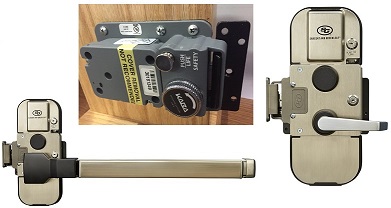|
GSA-approved security file cabinets, map and plan containers, vault doors, and doors to facilities approved for open
storage of classified information must be secured with a lock that has been tested and approved against Federal Specification FF-L-2740.
Since March 10 1992, GSA-approved security containers and vault doors for the protection of classified material have had FF-L-2740 compliant locks installed at time of manufacture.
Since February 15, 2015, all such containers and vault doors have been manufactured with a lock that is approved against Federal Specification
FF-L-2740B,
Locks, Combination, Electromechanical and its
Amendment 2.
|
|
Field safes use a mechanical combination lock meeting Federal Specification
FF-L-2937,
Combination Locks, Mechanical for new models and
(UL) Standard 768, Group 1
lock for existing field safes.
If the existing UL 768, Group 1 lock fails, or requires replacement, it must be replaced with a lock meeting FF-L-2937.
Federal Specification
FF-L-2938,
Locks, Combination, Electromechanical, US Allies
describes the U.S. Government's requirements and expectations for a combination lock designed and manufactured specifically to protect
unattended US and foreign national security information (NSI) provided to foreign military and civilian governments as specified in 32 CFR 2001.54 & 2001.55.
|
|
Six locks have been approved under FF-L-2740 for the protection of classified material. The Mas-Hamilton
Group model X-07 lock was approved in February 1992, the X-08 in March 1999, the Kaba Mas X-09 in June 2002,
the Sargent & Greenleaf model 2740 in June 2010, the Kaba Mas X-10 in April 2013, and the Sargent & Greenleaf model 2740B in November 2013.


FF-L-2740B Locks
The Department of Defense uses two types of mounted combination locks, one for the protection of classified material and one for the protection of weapons and ammunition.
Combination locks that protect weapons and ammunition must meet the requirements of Federal Specification FF-L-2937, Combination Locks, Mechanical
and its Amendment 2 for new containers.
Existing weapons and ammunition containers may continue to use combination locks that meet the requirements of Underwriters Laboratories Inc. (UL) Standard 768, Group 1.
If the existing UL 768, Group 1 mechanical combination lock fails, or requires replacement, it must be replaced with a lock meeting FF-L-2937.

FF-L-2937 Lock
Pedestrian door deadbolt devices are covered by Federal Specification
FF-L-2890C.
Lock Extensions (Pedestrian Door Lock Assembly Preassembled, Panic and Auxiliary Deadbolt) are intended for use on pedestrian doors to secure rooms and Sensitive Compartmented Information Facilities (SCIFs).
Devices approved under FF-L-2890C Type I through Type IV and Type VII through Type X meet life safety requirements.
It is important to check with your local fire marshal (Authority Having Jurisdiction-AHJ) to determine rooms/facilities where the occupancy is equal to or greater than what they consider meeting assembly requirements.
This will help you identify which pedestrian door deadbolt device you should use.

FF-L-2890C Pedestrian Door Deadbolt Devices
Combination padlocks under the
FF-P-110J,
Padlock, Changeable Combination Federal Specification are intended for protection against manipulation or
surreptitious attacks. The padlocks are intended for use indoors, ashore and aboard ocean-going vessels.

FF-P-110J Lock
|